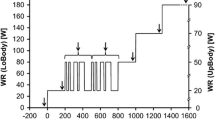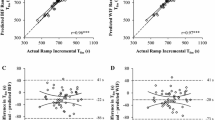Abstract
Published literature asserts that cardiac output (Q̇=V̇O2×1/C(a-v)O2) increases as a linear function of oxygen uptake with a slope of approximately 5–6 during constant work rate exercise. However, we have previously demonstrated that C(a-v)O2 has a linear relationship as a function of V̇O2 during progressively increasing work rate incremental exercise. Therefore, we hypothesized that Q̇ may indeed have a non-linear relationship with respect to V̇O2 during incremental, non-steady state exercise. To investigate this hypothesis, we performed five maximal progressive work rate exercise studies in healthy human subjects. Q̇ was determined every minute during exercise using measured breath-by-breath V̇O2, and arterial and pulmonary artery measurements of PO2, hemoglobin saturation, and content. Q̇ was plotted as a function of V̇O2 and the linear and non-linear (first order exponential and hyperbolic) fits determined for each subject. Tests for linearity were performed by assessing the significance of the quadratic terms added to the linear relation using least squares estimation in linear regression. Linearity was inadequate in all cases (group P<0.0001). We conclude that cardiac output is a non-linear function of V̇O2 during ramp-incremental exercise; the pattern of non-linearity suggests that while the kinetics of Q̇ are faster than those of V̇O2 they progressively slow as work rate (and V̇O2) increases.




Similar content being viewed by others
References
ATS/ACCP (2003) Joint statement on cardiopulmonary exercise testing. ATS/ACCP Statement on cardiopulmonary exercise testing. Am J Respir Crit Care Med 167:211–277
Barstow TJ, Mole PA (1991) Linear and non-linear characteristics of oxygen uptake kinetics during heavy exercise. J Appl Physiol 71:2099–2106
Beaver WL, Wasserman K, Whipp BJ (1986) A new method for detecting the anaerobic threshold by gas exchange. J Appl Physiol 60:2020–2027
Davies CTM, Prampero PE di, Cerretelli P (1972) Kinetics of cardiac output and respiratory gas exchange during exercise and recovery. J Appl Physiol 32:618–625
DeCort SC, Innes JA, Barstow TJ, Guz A (1991) Cardiac output, oxygen consumption, and arteriovenous oxygen difference following a sudden rise in exercise level in humans. J Appl Physiol 441:501–512
Fick A (1870) The output of the heart. Phys Med Ges 2:XVI
Harrell FE (2001) Regression modeling strategies. Springer, Berlin Heidelberg New York
Motulsky HJ, Lennart AF (1987) Fitting curves to data using nonlinear regression: a practical and nonmathematical review. Fed Proc 1:365–374
Ozyener F, Rossiter HB, Ward SA, Whipp BJ (2001) Influence of exercise intensity on the on- and off-transient kinetics of pulmonary oxygen uptake in humans. J Physiol (Lond) 533:891–902
Prampero PE di, Mahler PB, Giezendanner D, Cerretelli P (1989) Effects of priming exercise on V̇O2 kinetics and V̇O2 deficit at the onset of stepping and cycling. J Appl Physiol 66:2023–2031
Rowell LB (1986) Circulatory adjustments to dynamic exercise. In: Rowell LB (ed) Human circulation regulation during physical stress. Oxford University Press, New York, pp 213–256
Seldinger SI (1953) Catheter replacement of the needle in percutaneous arteriography: a new technique. Acta Radiol 39:368–376
Stringer WW, Hansen JE, Wasserman K (1997) Cardiac output estimated noninvasively from oxygen uptake during exercise. J Appl Physiol 82:908–912
Tschakovsky ME, Hughson RL (1999) Interaction of factors determining oxygen update at the onset of exercise. J Appl Physiol 86:1101–1113
Wasserman K, Hansen JE, Sue DY, Casaburi R, Whipp BJ (1999) Principles of exercise testing and interpretation: pathophysiology and clinical applications. Lippincott Williams & Wilkins, Baltimore, Md.
Whipp BJ, Ward SA (1982) Cardiopulmonary coupling during exercise. J Exp Biol 100:175–193
Yoshida T, Whipp BJ (1994) Dynamic asymmetries of cardiac output transients in response to muscular exercise in man. J Physiol (Lond) 480:355–359
Author information
Authors and Affiliations
Corresponding author
Rights and permissions
About this article
Cite this article
Stringer, W.W., Whipp, B.J., Wasserman, K. et al. Non-linear cardiac output dynamics during ramp-incremental cycle ergometry. Eur J Appl Physiol 93, 634–639 (2005). https://doi.org/10.1007/s00421-004-1258-3
Accepted:
Published:
Issue Date:
DOI: https://doi.org/10.1007/s00421-004-1258-3




